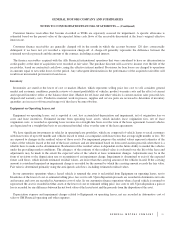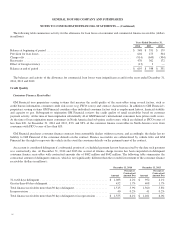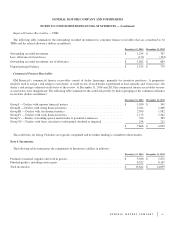General Motors 2014 Annual Report Download - page 76
Download and view the complete annual report
Please find page 76 of the 2014 General Motors annual report below. You can navigate through the pages in the report by either clicking on the pages listed below, or by using the keyword search tool below to find specific information within the annual report.GENERAL MOTORS COMPANY AND SUBSIDIARIES
NOTES TO CONSOLIDATED FINANCIAL STATEMENTS — (Continued)
Valuation of Cost and Equity Method Investments
When events and circumstances warrant, investments accounted for under the cost or equity method of accounting are evaluated for
impairment. An impairment charge is recorded whenever a decline in value of an investment below its carrying amount is determined
to be other-than-temporary. Impairment charges related to equity method investments are recorded in Equity income. Impairment
charges related to cost method investments are recorded in Interest income and other non-operating income, net.
Property, net
Property, plant and equipment, including internal use software, is recorded at cost. Major improvements that extend the useful life
or add functionality of property are capitalized. The gross amount of assets under capital leases is included in property, plant and
equipment. Expenditures for repairs and maintenance are charged to expense as incurred. We depreciate all depreciable property using
the straight-line method. Leasehold improvements are amortized over the period of lease or the life of the asset, whichever is shorter.
The amortization of the assets under capital leases is included in depreciation expense. Upon retirement or disposition of property,
plant and equipment, the cost and related accumulated depreciation are removed from the accounts and any resulting gain or loss is
recorded in earnings. Impairment charges related to property are recorded in Automotive cost of sales, Automotive selling, general
and administrative expense or GM Financial operating and other expenses.
Special Tools
Special tools represent product-specific powertrain and non-powertrain related tools, dies, molds and other items used in the vehicle
manufacturing process. Expenditures for special tools are recorded at cost and are capitalized. We amortize all non-powertrain special
tools over their estimated useful lives using an accelerated amortization method. We amortize powertrain special tools over their
estimated useful lives using the straight-line method. Impairment charges related to special tools are recorded in Automotive cost of
sales.
Goodwill
Goodwill arises from the application of fresh-start reporting and acquisitions accounted for as business combinations. Goodwill is
tested for impairment for all reporting units on an annual basis as of October 1, or more frequently if events occur or circumstances
change that would warrant such a review. Our reporting units are GMNA and GME and various reporting units within the GMIO,
GMSA and GM Financial segments. When performing our goodwill impairment testing, the fair values of our reporting units are
determined based on valuation techniques using the best available information, primarily discounted cash flow projections. We make
significant assumptions and estimates, which utilize Level 3 measures, about the extent and timing of future cash flows, growth rates,
market share and discount rates that represent unobservable inputs into our valuation methodologies. Our fair value estimates for
annual and event-driven impairment tests assume the achievement of the future financial results contemplated in our forecasted cash
flows and there can be no assurance that we will realize that value. The valuation methodologies utilized to perform our goodwill
impairment testing were consistent with those used in our application of fresh-start reporting on July 10, 2009 and in any subsequent
annual or event-driven goodwill impairment tests and utilized Level 3 measures. Because the fair value of goodwill can be measured
only as a residual amount and cannot be determined directly we calculate the implied goodwill for those reporting units failing Step 1
in the same manner that goodwill is recognized in a business combination pursuant to Accounting Standards Codification (ASC) 805.
Intangible Assets, net
Intangible assets, excluding goodwill, primarily include brand names, technology and intellectual property, customer relationships
and dealer networks. Intangible assets are amortized on a straight-line or an accelerated method of amortization over their estimated
useful lives. An accelerated amortization method reflecting the pattern in which the asset will be consumed is utilized if that pattern
can be reliably determined. We consider the period of expected cash flows and underlying data used to measure the fair value of the
intangible assets when selecting a useful life. Impairment charges related to intangible assets are recorded in Automotive selling,
76
























